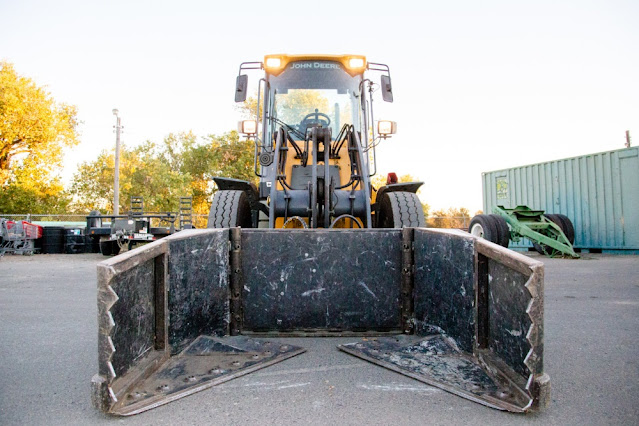
Leaf season and street pick-up extended through Feb. 6

|
| The Claw will be performing street pick-ups later into the year, the City of Sacramento decided. (Photo courtesy city of Sacramento) |
Sacramento’s leaf season is lasting longer this new year.
Instead of its original Jan. 23 cutoff date, the City of Sacramento extended its in-street pick-up of garden waste and Christmas trees two weeks. The last date to put green waste curbside is now Feb. 6.
A quirky Sacramento tradition, in-street pick-up is limited to November through January. But city crews that operate The Claw – the articulated tractor used to scoop up the piles – have been running way behind schedule. Due to staffing shortages, Sacramento has been operating only five Claw crews; in past years, they’ve had eight.
Heavy storms in October and December further complicated pick-ups. Meanwhile, piles in some leafy neighborhoods continued to grow and grow. Both the Sacramento Bee and local TV stations reported this week about delays. The City of Sacramento already had extended its leaf season schedule to attempt to catch up.
Usually, The Claw visits residential streets seven times during leaf season, with pick-ups spaced about two weeks apart. Residents can get an estimate of when The Claw will arrive on their street using the Leaf Season collection calendar. Find the link at S acLeafSmart.org .
Some reminders:
* When recycling Christmas trees, trees should be clean of all lights, tinsel, tree stands, nails and decorations. Flocked trees will be accepted.
* Leaf piles can be no bigger than 4 by 4 by 9 feet (and just one per household). Make sure there is space between the pile and the curb so water can flow down the gutter. Also, place the pile at least 6 feet away from cars, boats, basketball hoops or other obstructions. The Claw needs room to maneuver.
* Don’t put plastic bags in street piles (including bags full of leaves). And don’t contaminate the leaf pile with trash or dog poop (a common problem).
* During leaf season, the City of Sacramento continues to pick up green waste containers. Fill those first before piling leaves in the street, advises the recycling and solid waste department. The containers will get picked up 13 times during Leaf Season while residents can expect seven visits from The Claw.
For more information: SacLeafSmart.org .
Comments
0 comments have been posted.Sacramento Digs Gardening to your inbox.
Food in My Back Yard Series
May 6: Maintain soil moisture with mulch for garden success
April 29: What's (already) wrong with my tomato plants?
April 22: Should you stock up on fertilizer? (Yes!)
April 15: Grow culinary herbs in containers
April 8: When to plant summer vegetables
April 1: Don't be fooled by these garden myths
March 25: Fertilizer tips: How to 'feed' your vegetables for healthy growth
March 18: Time to give vegetable seedlings some more space
March 11: Ways to win the fight against weeds
March 4: Potatoes from the garden
Feb. 25: Plant a fruit tree now -- for later
Feb. 18: How to squeeze more food into less space
Feb. 11: When to plant? Consider staggering your transplants
Feb. 4: Starting in seed starting
Sites We Like
Garden Checklist for week of May 11
Make the most of the lower temperatures early in the week. We’ll be back in the 80s by Thursday.
* Plant, plant, plant! It’s prime planting season in the Sacramento area. Time to set out those tomato transplants along with peppers and eggplants. Pinch off any flowers on new transplants to make them concentrate on establishing roots instead of setting premature fruit.
* Direct-seed melons, cucumbers, summer squash, corn, radishes, pumpkins and annual herbs such as basil.
* Harvest cabbage, lettuce, peas and green onions.
* In the flower garden, direct-seed sunflowers, cosmos, salvia, zinnias, marigolds, celosia and asters. (You also can transplant seedlings for many of the same flowers.)
* Plant dahlia tubers.
* Transplant petunias, marigolds and perennial flowers such as astilbe, columbine, coneflowers, coreopsis, dahlias, rudbeckia and verbena.
* Keep an eye out for slugs, snails, earwigs and aphids that want to dine on tender new growth.
* Feed summer bloomers with a balanced fertilizer.
* For continued bloom, cut off spent flowers on roses as well as other flowering plants.
* Add mulch to the garden to maintain moisture. Mulch also cuts down on weeds. But don’t let it mound around the stems or trunks of trees or shrubs. Leave about a 6-inch-to-1-foot circle to avoid crown rot or other problems.
* Remember to weed! Pull those nasties before they set seed.
* Water early in the day and keep seedlings evenly moist.